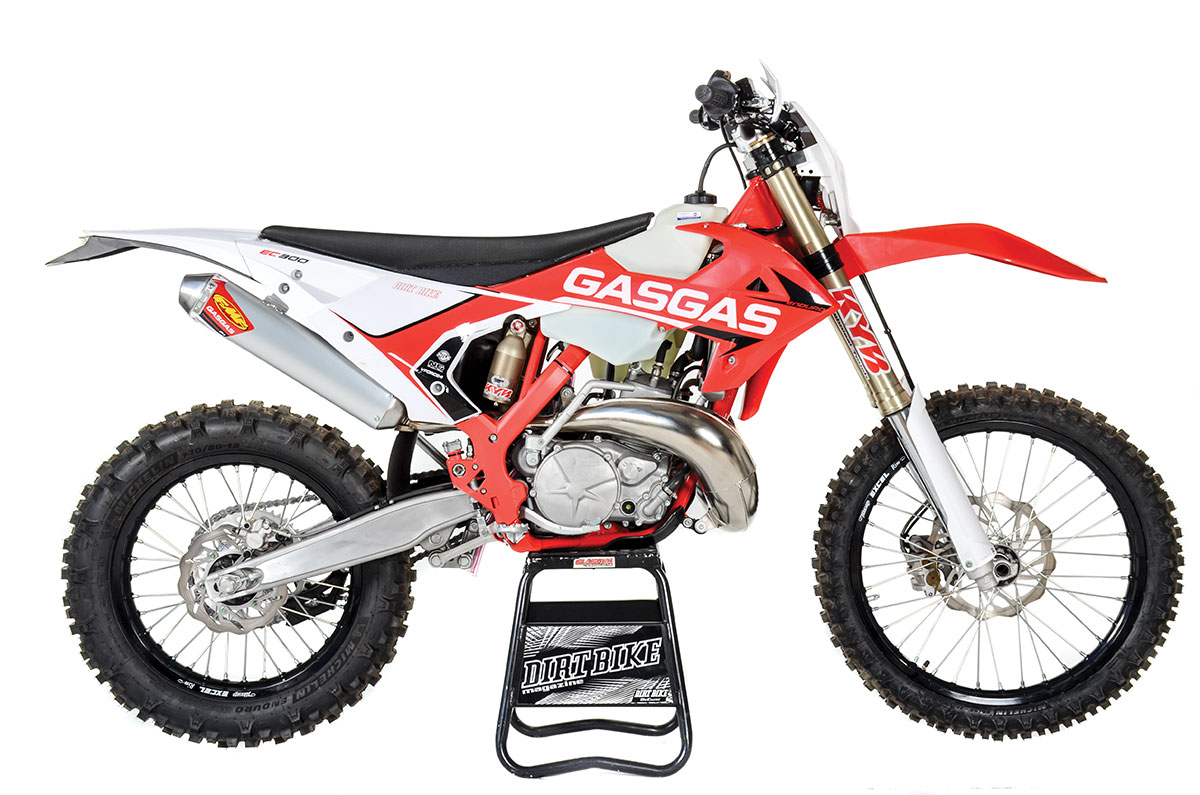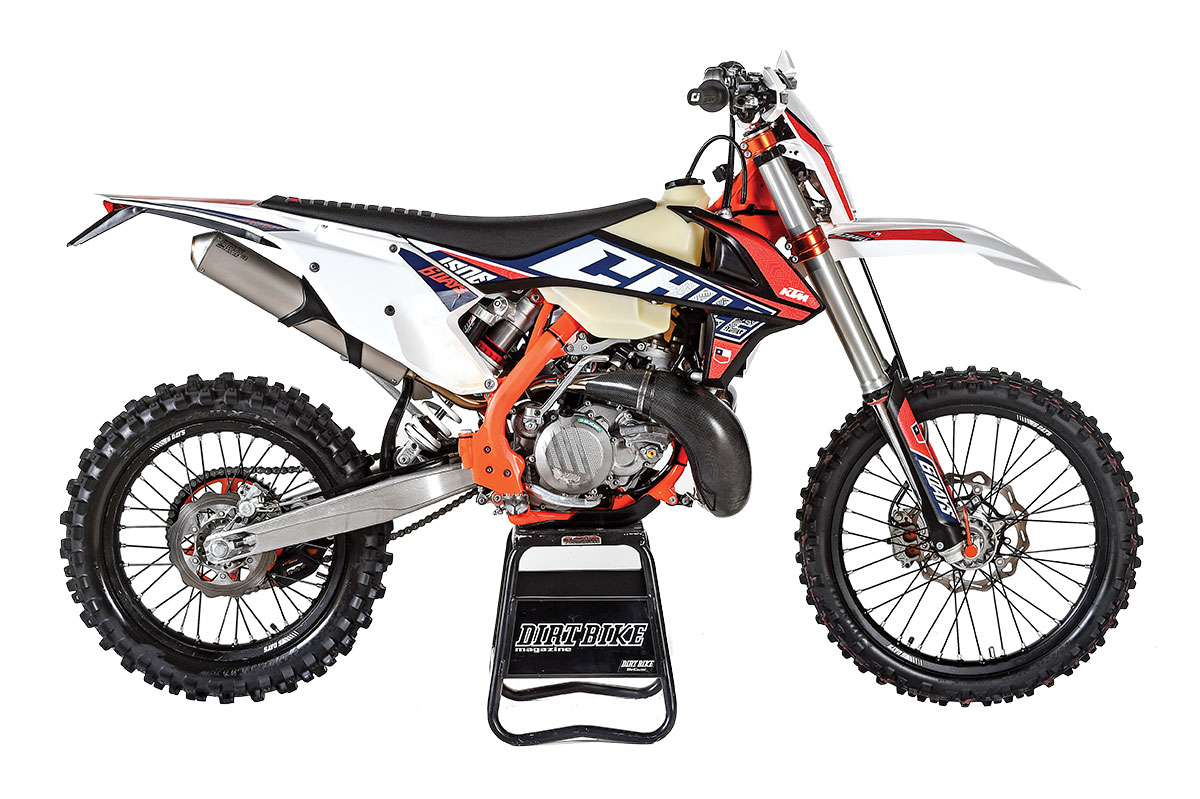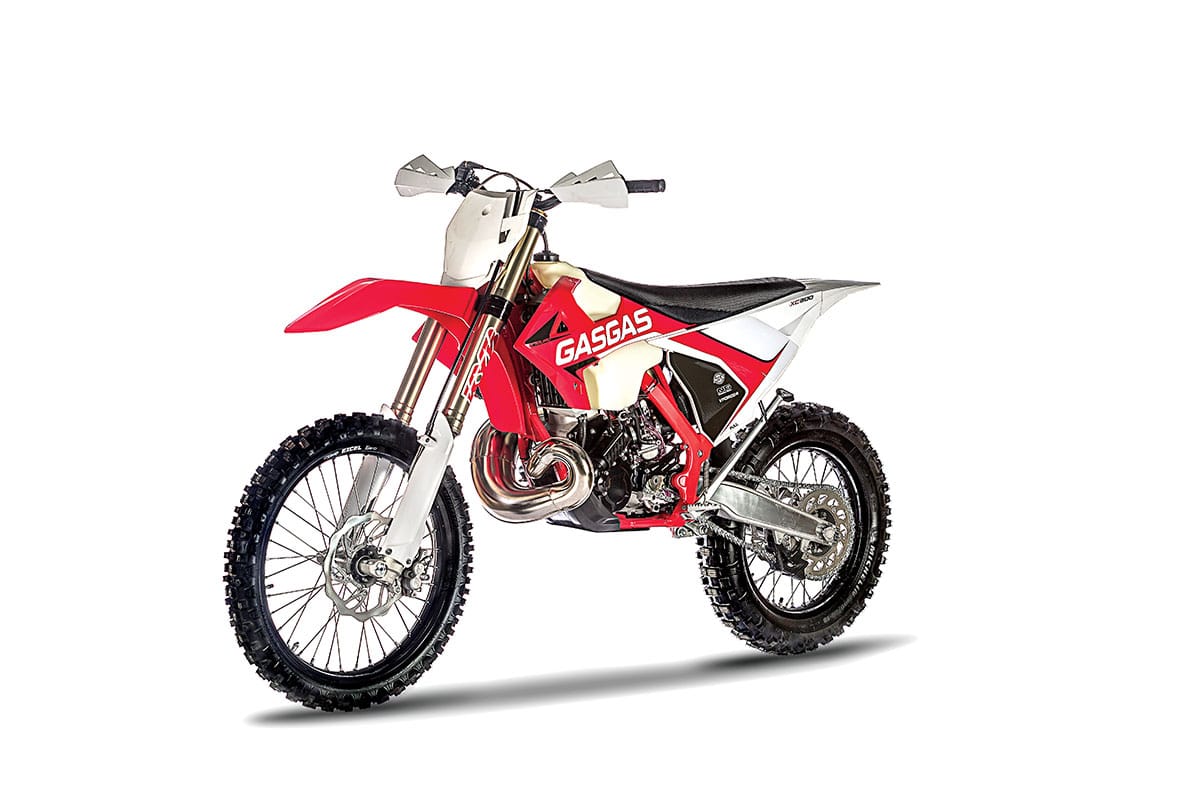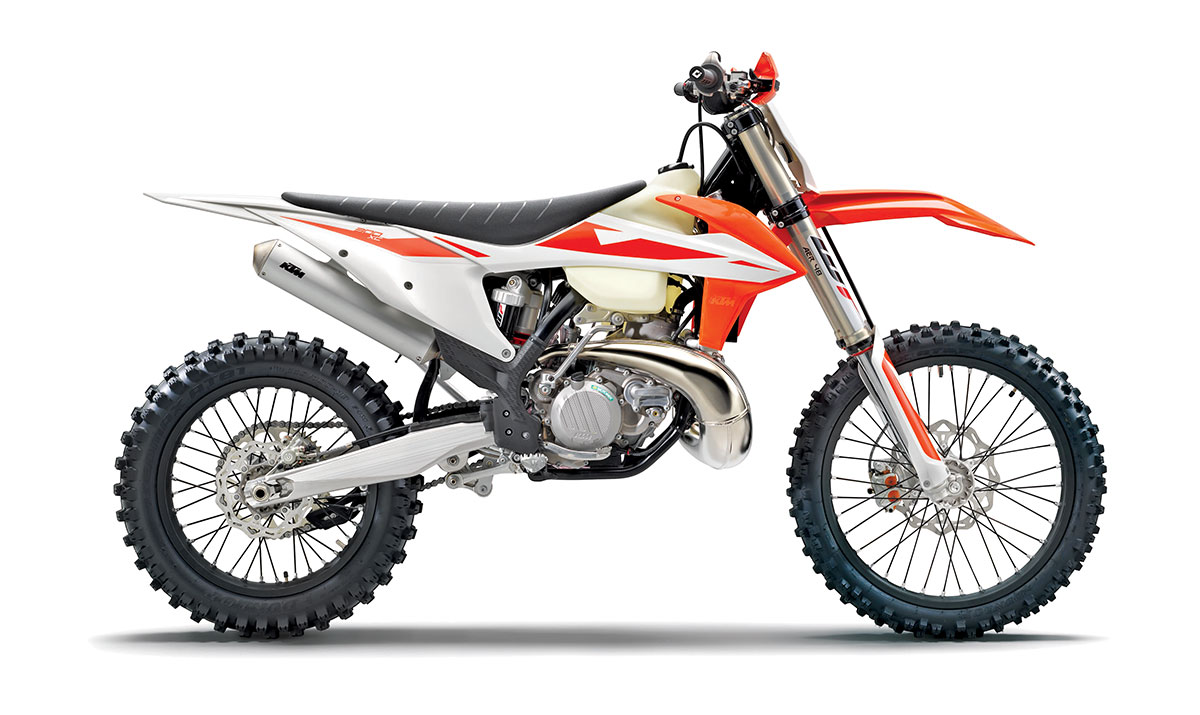In the course of the 2019 model season, we’ve ridden most of the 300s that are offered in the U.S. We haven’t necessarily had them all at the same time or in the same place, but we have developed a very good feel for them, what each does well and where each is designed to be ridden. This is a summary of the 300s we’ve tested so far, followed by comments on their strengths and weaknesses. We also have rated them according to various applications. Trail riding is all about how well a bike works when racing isn’t the priority. On the trail, it’s about how easy a bike is to ride, and fun is the ultimate priority. Eastern competition is concerned with riding hard on tight trials with mud, roots and trees. Western competition deals with higher speeds, bigger bumps and has an element of motocross. Extreme riding is where virtually all 300 two-strokes excel, dealing with obstacles that push the limits of a rider’s skill and comfort, whatever level that is. Finally, ownability is a catch-all that rates a bike for reliability, access and availability. Here’s how we see the current crop of 300 two-strokes.
For a buyer’s guide of all 2019 two-strokes, click here.
BETA XTRAINER
 When we say that the 300 class is full of diverse and nonconforming bikes, the Beta Xtrainer is the one we think of first. It’s unique. Some people think it’s an entry-level bike. Some think it’s some sort of a trials halfbreed, and others say it’s an extreme trail bike. It’s all that, but one word defines it even better: bargain. The Xtrainer is priced lower than any high-level European off-road bike. It sells for $7499. Beta took the 300RR and shrunk it by about 15 percent. It’s 1 1/4-inch lower than the RR model and is a few pounds lighter. It has oil injection and is tuned for low-end torque through porting, exhaust and a spacer in the intake.
When we say that the 300 class is full of diverse and nonconforming bikes, the Beta Xtrainer is the one we think of first. It’s unique. Some people think it’s an entry-level bike. Some think it’s some sort of a trials halfbreed, and others say it’s an extreme trail bike. It’s all that, but one word defines it even better: bargain. The Xtrainer is priced lower than any high-level European off-road bike. It sells for $7499. Beta took the 300RR and shrunk it by about 15 percent. It’s 1 1/4-inch lower than the RR model and is a few pounds lighter. It has oil injection and is tuned for low-end torque through porting, exhaust and a spacer in the intake.
STRENGTHS
Considering the price, the size and the fact that it has oil -injection, we can see how it would appeal to an entry-level buyer, but the Xtrainer also attracts experienced off-road riders. With such smooth, rich low-end power and a slow-revving delivery, it’s almost impossible to stall without deliberately standing on the rear brake. It starts easily and doesn’t overheat at low speed, thanks to a radiator fan. The brakes, bars, hydraulic clutch and most components are of very high quality. The price is great, but nothing about the Xtrainer is budget.
WEAKNESSES
Peak power was sacrificed in order to gain all that torque. The fork and shock are built by the Spanish company Olle, presumably to achieve the lower retail price. The suspension is excellent at lower speeds but too soft for faster riding. The engine has some vibration, and there’s no kickstarter as a backup.
BOTTOM LINE
If more riders understood the Xtrainer, it would probably be the best-selling bike in the class. Everyone likes it, regardless of skill level. It’s no racer, but most riders aren’t either.
TRAIL 5.0 out of 5.0 stars
EASTERN COMPETITION 3.0 out of 5.0 stars
WESTERN COMPETITION 1.0 out of 5.0 stars
EXTREME RIDING 5.0 out of 5.0 stars
OWNABILITY 3.0 out of 5.0 stars
PRICE: $7499
WEIGHT WITHOUT FUEL: 226 lb.
BETA 300RR
The Beta 300RR is one of three 300cc two-strokes offered by Beta. It’s more of a general purpose off-road bike, while the Race Edition is more competition oriented and the Xtrainer is a pure trail bike. When the 300RR arrived about four years ago, it blew us away because it was so much more refined than we thought possible from such a small company. The KTM of the time was showing its age. It was Beta, and this bike that really woke KTM up and made KTM put more emphasis on its own 300. Over the years the Beta has become more refined with features like oil injection.
STRENGTHS
In most objective measures of performance, the Beta is as good as anything on the market. It’s powerful, reasonably light and very stable. At 229 pounds, it’s lighter than either of the fuel-injected 300s. The jetting is nearly flawless, whereas most of the others have lean surges down low. The Beta has a light clutch pull and excellent gear spacings for general riding.
WEAKNESSES
Time has caught up with the Beta somewhat. Compared to the latest KTM and Husky, which have counterbalancers, it vibrates noticeably. Also, the Beta doesn’t have quite as much power at the rpm extremes, very low and very high. The Sachs ZF fork can be harsh on sharp impacts but still feels somewhat soft overall.
BOTTOM LINE
Beta has built an identity as a legitimate alternative to KTM and Husky with no significant drawbacks. At one time, there were legitimate reasons to go Beta over the 300 mainstays. Now, all the other 300s have closed in, mostly because Beta raised the bar for the entire class.
TRAIL4.0 out of 5.0 stars
EASTERN COMPETITION4.0 out of 5.0 stars
WESTERN COMPETITION4.0 out of 5.0 stars
EXTREME RIDING4.0 out of 5.0 stars
OWNABILITY3.0 out of 5.0 stars
PRICE: $8899
WEIGHT WITHOUT FUEL: 229 lb.
GAS GAS EC300
The 2019 Gas Gas EC300 is fit with a new chromoly backbone frame, allowing for a better ergonomic fit at the tank and good feel with proper flex points. Gas Gas shelved the Marzocchi and Reiger suspension units in favor of KYB dampers, with the front being the AOS cartridge unit praised for both feel and damping versatility. The engine is a case reed design, electric start (along with a kickstarter) and carbureted by a Keihin PWK-38, which flows into a V-Force reed assembly. The muffler is a longish FMF piece, the clutch hydraulic, and the starting is button or kick.
STRENGTHS
Handling and suspension are strong points in the Gas Gas arsenal. The KYB suspension is both firm and plush enough, giving it great versatility for the off-roader. Handling-wise, it’s very balanced, corners nicely and the ergos are spaced out and comfortable. It has a nice easy clutch pull, and the Nissin brakes are strong and progressive. Power is soft down low; the middle has decent meat to it, and it pulls fairly hard on top. It craves technical trails where you keep the revs down and make the rear wheel hook up.
WEAKNESSES
While the power is smooth, it lacks good bottom-to-mid muscle. Vibration is noticeable. The dual map switch has a “rain mode” that further softens the hit, but it works nicely in slick terrain. We blew a fork seal early on, and while the exhaust is soft via the FMF muffler, we’d like to be able to retrofit it with a spark arrestor.
BOTTOM LINE
This is a strong performer on the handling side and middle of the road in the power department. A wide range of riders will love the suspension and give a thumbs up to the handling. For pilots used to the old two-strokes, this machine has a heavy crank feel and likes to tractor in the woods but does vibrate. It starts easily. The brakes are strong. The clutch pull is light. The cockpit is well laid out, and it actually feels lighter than its 234 pounds.
TRAIL4.0 out of 5.0 stars
EASTERN COMPETITION3.0 out of 5.0 stars
WESTERN COMPETITION3.0 out of 5.0 stars
EXTREME RIDING3.0 out of 5.0 stars
OWNABILITY3.0 out of 5.0 stars
PRICE: $9299
WEIGHT WITHOUT FUEL: 234 lb.
For a full test of the Gas Gas EC300, click here
HUSQVARNA TE300i
Husqvarna is in the fuel-injected two-stroke business alongside KTM, but the TE300i is a very different bike. In order to give the Husky brand its own identity, the TE has a number of different features, including linkage rear suspension, different bodywork and a different look. The brakes and the clutch hydraulics are made by Magura rather than Brembo. The airbox and subframe are integrated on the Husky, and that results in different intake flow and a slightly different power delivery. The engine, on the other hand, is exactly the same as that in the KTM 300XC-W TPI, counterbalancer shaft and all. It has the same fuel-delivery concept, where it injects fuel directly into the transfer ports and a light mist of oil into the intake manifold, eliminating the need for premixed fuel. The TE has the WP Xplor 48 coil-spring fork, which is seen as the most trail-oriented unit in WP’s arsenal.
STRENGTHS
What really stands out about this 300 is a freakish lack of vibration. You don’t realize how much two-strokes without counterbalancers buzz until you ride one back to back with the TE. On top of that, the powerband is virtual magic. It pulls from incredibly low rpm and is very difficult to stall. The power is smoother than the carbureted Husky TX300’s and even slightly smoother than the KTM 300XC-W’s. The rear suspension, on the other hand, is a bit more aggressive than the PDS no-linkage rear end on the XC-W, meaning that bike is more balanced at higher speeds. It’s still very soft, overall, however. The TPI fuel-delivery results in excellent performance at altitude and increased fuel range. The mileage is only about 10 percent better at sea level but progressively better at higher altitudes.
WEAKNESSES
This bike is less race-oriented than Husqvarna’s own carbureted TX300 for a number of reasons. It has a nearly hitless power delivery. It’s not quite as fast on top, and the Xplor 48 fork doesn’t like being worked very hard. At faster paces, it’s very divey and somewhat harsh. The TPI bike is heavier than a conventional two-stroke, although the TE still feels comparatively light. This year we’ve experienced none of the glitches that plagued the early TPI bikes, but that doesn’t mean they’re gone for good. Owners need to be aware that this is new technology and be willing to update firmware as it becomes available.
BOTTOM LINE
This is one of our all-time favorite trail bikes. The counterbalancer is the biggest reason, and we’ve warmed up to Transfer Port Injection. It might seem like no big deal, but we still love a bike with a headlight and odometer. For racing, we still prefer its carbureted siblings, the TX300 and 300XC, mostly because of their firmer suspension.
TRAIL5.0 out of 5.0 stars
EASTERN COMPETITION4.0 out of 5.0 stars
WESTERN COMPETITION3.0 out of 5.0 stars
EXTREME RIDING4.0 out of 5.0 stars
OWNABILITY4.0 out of 5.0 stars
PRICE: $9899
WEIGHT WITHOUT FUEL: 237 lb.
HUSQVARNA TX300

This is the only bike in the Husqvarna TX line, which is the designation used to signify a two-stroke off-road racer. In KTM language, it would be an XC. The TE300i mentioned earlier, on the other hand, is more trail oriented. To help with its racer creds, the TX has a completely different frame and suspension, very similar to that of a current Husky motocross bike. Also like the motocross bikes, the TX’s fork is the WP AER 48 air suspender, as opposed to the Xplor 48 on the TE. The biggest difference of all is that the 2019 TX still has a Mikuni carburetor rather than TPI electronic fuel delivery. That will change for 2020.
STRENGTHS
This bike is a rolling mass of strong points. The motor has excellent power down low, on top and everywhere between. It can perform at low rpm just above idle, and it has instant snap when it’s time to go. The suspension is clearly oriented toward faster riding, but the beauty of an air fork is that you can lower the pressure when tight trails and slow speeds are on the menu. The brakes are excellent. The hydraulic clutch has a light pull, and the counterbalanced motor has very little vibration. If you are mistrustful of technology, the carb is a good thing. This is a very light bike at 219 pounds without fuel. It also has a kickstarter back-up for the button.
WEAKNESSES
If you’re really picky, you will notice that the bike feels very lean at small throttle openings, with some surging and slight detonation. For extreme riders used to PDS suspension, the linkage hangs down and can catch on logs. It has no headlight, odometer, radiator fan or skid plate.
BOTTOM LINE
The TX300 is clearly a race bike at heart, but it’s one of the only race machines that makes a truly great trail bike as well. Traditionalists love the carb and the fact that they won’t be anyone’s guinea pig.
TRAIL4.0 out of 5.0 stars
EASTERN COMPETITION4.0 out of 5.0 stars
WESTERN COMPETITION5.0 out of 5.0 stars
EXTREME RIDING3.0 out of 5.0 stars
OWNABILITY5.0 out of 5.0 stars
PRICE: $9599
WEIGHT WITHOUT FUEL: 219 lb.
KTM 300XC-W TPI SIX DAYS EDITION
The KTM 300XC-W Six Days Edition is really a spiced-up 300XC-The KTM 300XC-W Six Days Edition is really a spiced-up 300XC-W. The big news is that it received TPI fuel injection. It injects fuel directly into the transfer ports and a light mist of oil into the intake manifold, eliminating the need for premixed fuel. The engine is counterbalanced to eliminate vibration and is a six- speeder with a Brembo hydraulic clutch. The 300 is fit with PDS rear suspension without linkage, and a coil-spring WP Xplor fork handles the suspension. The Six Days Edition gets a preload adjuster for the fork and machined orange-anodized triple clamps. It also has a map switch (the handlebar-mounted map switch changes the ignition timing curve from the standard mode to a mellower dumbed-down mode for slick conditions), a Supersprox two-piece rear sprocket, a floating front brake disc, a solid rear brake disc, a Selle Dalla Valle Wave Factory Racing seat, a skid plate, a carbon -fiber pipe guard and a front axle puller. There are lots of cosmetic additions that are highlighted by the orange frame. Six Days logos appear on the graphics, the handlebar, the silencer and the rims.
STRENGTHS
Electric start, a vibration-free feel to power and incredibly smooth bottom-to-mid juice allow the off-roader to get traction and let the engine pull him over obstacles. The six-speed gearbox is well-spaced for the most part. The clutch pull is light and easy to feather. When you add good fuel economy and oil injection to the engine’s superb hitless power, you have a true enduro weapon. The WP suspension is super plush, and PDS fans love the fact that it has no linkage to hang up.
WEAKNESSES
The injected 300 TPI machine is mapped quite lean, and you feel it when you push the engine hard on long climbs. It doesn’t like to be over revved; short shifting is the key to success with this powerband. KTM does offer a competition map for those who want to richen up the powerband. Contact your dealer for information. For more aggressive or bigger pilots, the suspension is way too soft. The fork dives easily, making the ride a seesaw affair in faster terrain. The trick seat cover is hard and slick, and the lack of a spark arrestor is irritating, as it is with all these bikes.
BOTTOM LINE
KTM has rejuvenated the two-stroke line with the counterbalanced engine. The virtual lack of vibration is a huge benefit! The performance of the TPI machine is smooth, powerful and seamless where the off-roader needs tractable power. This machine will make you a better and more efficient off-road rider. Button start, perfect enduro power and oil injection add up to a big win.
TRAIL5.0 out of 5.0 stars
EASTERN COMPETITION4.0 out of 5.0 stars
WESTERN COMPETITION3.0 out of 5.0 stars
EXTREME RIDING5.0 out of 5.0 stars
OWNABILITY4.0 out of 5.0 stars
PRICE: $10,899
WEIGHT WITHOUT FUEL: 233 lb.
For a full test of the 2019 KTM 300XC-W, standard edition, click here.
SHERCO 300SE FACTORY![]()
As we reported, we didn’t ride all these 300s in the same place or at the same time. Several months ago we went to Nimes, France, to ride all the 2019 Shercos, including the 300SE Factory edition. In Sherco-speak, the Factory is a premium model that gets a number of upgrades over the Racing version. The most important of those is the KYB fork. The bike has an electronic power valve, a handlebar-mounted map switch, electric start, a hydraulic clutch, Brembo brakes and a Neken handlebar. It’s one of the few 300s that has a radiator fan.
STRENGTHS
The Sherco might well be the most powerful of the 300 two-strokes. It has impressive midrange, and if it’s too much for the conditions, the handlebar-mounted map switch is there to calm things down. The mild map is legit; it really does take away some hit and make the bike more manageable. The KYB suspension is very good and well worth the extra price for the Factory version. The brakes are excellent, and so is the hydraulic clutch. We love that radiator fan and wish the others would follow suit.
WEAKNESSES
The Sherco 300 isn’t the easiest bike to ride. The power is concentrated in the middle, and there’s a lot of it. The mild map doesn’t actually increase torque down low; it just takes away the hit. The 300SE also feels heavy. In 2018 we had one in our shop, and it tipped the Dirt Bike scale at 244 pounds without fuel. The 2019 model didn’t feel much lighter.
BOTTOM LINE
The Sherco 300SE Factory is a high-end race bike for the young and the strong. Like all these 300 two-strokes, it’s excellent in tight, tough conditions. Dealers are scarce, but the importer has a good reputation for follow-up.
TRAIL3.0 out of 5.0 stars
EASTERN COMPETITION4.0 out of 5.0 stars
WESTERN COMPETITION3.0 out of 5.0 stars
EXTREME RIDING3.0 out of 5.0 stars
OWNABILITY3.0 out of 5.0 stars
PRICE: $9900
WEIGHT WITHOUT FUEL: Not available
For a full test of the 2018 Sherco 300, click here.
TM E300ES
TM Motorcycles used to have a reputation for being expensive, exotic and rare. Now that small European makers have become the norm in the 300 class, all of them are expensive, exotic and rare. For 2019 TM gave its 300 a new motor, complete with electric start. The cylinder is new. The cases are new, and the five-speed transmission is new. It already had an electric power valve, an aluminum frame, a KYB fork and a shock made in-house at TM. Interestingly enough, the bike was designed around Transfer Port Injection, similar to the system on the KTM 300XC-W TPI. This particular bike has a Keihin carb.
STRENGTHS
The new motor is incredibly smooth and torquey. TMs in the past were hard-hitting, pro-level bikes, but this one has a gentler side. The power is sweet and the jetting is clean. This is one of the lighter bikes in the class, at 225 pounds without fuel, and it still has a kickstarter. The KYB fork is good. The hydraulic clutch has a medium pull, and the Nissin brakes are as good as anything in the class.
WEAKNESSES
TM recommends that race fuel is to be used in the E300ES. That can get a little tiresome. This is the only 300 that uses an aluminum frame, and it feels very rigid. The rear suspension, in particular, can feel harsh.
BOTTOM LINE
We were surprised and pleased to see that TM has tamed the beast. The 300 was a brute in the old days, feeling more like a motocross bike than an off-roader. That’s not the case any more as far as the motor goes, but the chassis still has a very motocross-oriented feel.
TRAIL3.0 out of 5.0 stars
EASTERN COMPETITION3.0 out of 5.0 stars
WESTERN COMPETITION4.0 out of 5.0 stars
EXTREME RIDING [usr 3 text=”false”]
OWNABILITY3.0 out of 5.0 stars
PRICE: $9495
WEIGHT WITHOUT FUEL: 225 lb.
THE REST OF THE BEST
There are more. The 300 class is large and healthy in America. Here are some of the bikes that we have yet to test in 2019.
BETA 300RR RACE EDITION: This is a competition-oriented version of the 300RR. It doesn’t have oil injection and weighs a few pounds less. The fork is upgraded to a Sachs closed-cartridge system with more aggressive settings. The standard footpegs are swapped out for machined aluminum versions. It gets hand guards, and the price is still less than most other 300s. MSRP: $9299.
GAS GAS XC300: Gas Gas offers this model to appeal to western riders and those who simply don’t want to pay for a headlight or odometer. The XC is stripped of those items, but is otherwise the same bike as the EC300. The price is $300 less. MSRP: $8999.
KTM 300XC: This is KTM’s racier 300. It has a chassis that’s very similar to the 250SX motocross bike’s, but with a 300cc six-speed for a motor. Unlike the 300XC-W TPI, the 2019 300XC has a Mikuni carburetor. For 2020, however, it will be available only with TPI. The Husky TX300 mentioned earlier has the same frame, engine and suspension, but with some differing components and Husky bodywork. It shares most of the same weaknesses and strengths. MSRP: $9499.
SHERCO SE300 RACING: We rode this bike in France earlier in the year and found it was very similar to the upgraded SE300 Factory mentioned previously. This model has a WP fork instead of the KYB unit. It doesn’t get the FMF exhaust system or a skid plate. The price is $600 less. MSRP: $9300.
SHERCO SC300 CROSS-COUNTRY: To appeal to cross-country racers and motocrossers, Sherco offers a stripped version of the SE300 Factory. It has all the upgrades of the Factory model but with stiffer suspension settings. MSRP: $9700.
TM EN300i: Apparently, TM had access to Transfer Port Injection technology prior to KTM’s involvement. The TM 300i fuel-injected two-stroke has been years in the making. We were hoping to have the result in time for this story, but these things take time, especially for a company this small. It still should arrive as a 2019 model. MSRP: TBA.
TM MX 300 ES: TM is the only company to offer a 300cc two-stroke motocross bike in America. The MX300ES is similar to the EN300 tested in this issue but with more aggressive motor and suspension settings. It keeps the electric starter. MSRP: $9295.

























Comments are closed.